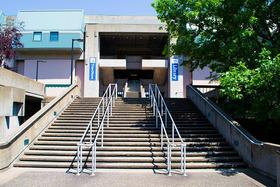- As part of Wright State University, the Lake Campus will be the focal point for the educational and cultural advancement of the residents of West Central Ohio, providing opportunities for advanced scholarship and continuing education, for economic and technological development, and for community service.
School Highlights
Wright State University-Lake Campus serves 1,629 students (46% of students are full-time).
The college's student-teacher ratio of 17:1 is lower than the state community college average of 22:1.
Minority enrollment is 12% of the student body (majority Black), which is less than the state average of 38%.
Quick Facts (2025-26)
- Enrollment: 1,629 students
- In-state tuition: $5,842
- Out-state tuition: $14,022
- Acceptance Rate: 98%
- Student-teacher ratio: 17:1
- Minority enrollment: 12%
- Source: Integrated Postsecondary Education Data System (IPEDS)
School Overview
The teacher population of 96 teachers has stayed relatively flat over five years.
Wright State University-Lake Campus
(OH) Community College Avg.
Carnegie Classification
Baccalaureate Colleges: Diverse Fields
Baccalaureate/Associate's Colleges: Mixed Baccalaureate/Associate's
Institution Level
Four or more years
At least 2 but less than 4 years
Institution Control
Public
Private not-for-profit
Total Faculty
96 staff
93 staff
School Calendar
Student Body
The student population of Wright State University-Lake Campus has stayed relatively flat over five years.
The student-teacher ratio of 17:1 has decreased from 18:1 over five years.
The Wright State University-Lake Campus diversity score of 0.22 is less than the state average of 0.58. The school's diversity has stayed relatively flat over five years.
Total Enrollment
1,629 students
757 students
Student-Teacher Ratio
17:1
22:1
# Full-Time Students
754 students
397 students
# Part-Time Students
875 students
360 students
# Enrollment Undergraduate
162 students
313 students
# Full-Time Undergraduate Students
754 students
385 students
# Full-Time Graduate Students
22 students
10 students
# Part-Time Undergraduate Students
874 students
434 students
# Part-Time Graduate Students
1 students
3 students
Total Dormitory Capacity
96 students
425 students
% Asian
1%
4%
% Hispanic
2%
6%
% Black
4%
15%
% White
88%
62%
% Hawaiian
n/a
2%
% Two or more races
3%
4%
% Non Resident races
n/a
1%
% Unknown races
n/a
6%
Diversity Score
0.22
0.58
College Completion Rate (Students who graduate in less than 4 years)
21%
23%
College Completion Rate (Students who graduate in 4 years or more than 4 years)
43%
22%
Average Graduate Earnings (10 Years)
$42,700
$31,900
Tuition and Acceptance Rate
The public in-state tuition of $5,842 is more than the state average of $5,163. The in-state tuition has declined by 13% over four years.
The public out-state tuition of $14,022 is more than the state average of $10,843. The out-state tuition has declined by 13% over four years.
In-State Tuition Fees
$5,842
$5,163
Out-State Tuition Fees
$14,022
$10,843
% Students Receiving Some Financial Aid
83%
88%
Median Debt for Graduates
$23,500
$18,500
Median Debt for Dropouts
$7,500
$6,500
Acceptance Rate
98%
73%
SAT Reading
395
510
SAT Math
445
495
SAT Writing
n/a
465
ACT Composite
21
20
ACT English
20
20
ACT Math
22
19
Source: 2024 (or latest year available) Integrated Postsecondary Education Data System (IPEDS) , School Administrators
School Notes
- School Mascot: Lowdy Laker
- Named after the world-famous Wright brothers, Wright State University in Dayton, Ohio, continues their spirit of innovation. The university serves nearly 17,000 students, offering more than 100 undergraduate and 50 Ph.D., graduate, and professional degrees. Western Ohio Educational Foundation officially opened its doors in the fall of 1962. With enrollment at 285 students, more than twice the number anticipated, the newly established foundation had begun the process whereby the communities' citizens could have immediate access to a college degree. The acquisition of a 173-acre site for the new campus on the northern shores of Grand Lake St. Marys. The first building on campus was Dwyer Hall, named in recognition of Minnie Dwyer's generous support and contains laboratories, classrooms, faculty and administrative offices, an auditorium, and student service facilities. Ground was broken in 1979 to expand the facilities for inclusion of additional two-year technical programs. The Lake Campus provides a variety of general education courses and certificate programs, as well as associate, bachelor's and master's degrees. A variety of preprofessional and certificate programs are also offered, as is participation in the Ohio Transfer Module. Wright State University is accredited at the doctoral degree-granting level by the North Central Association of Colleges and Schools.
Frequently Asked Questions
How much does Wright State University-Lake Campus cost?
Wright State University-Lake Campus's tuition is approximately $5,842 for In-State students and $14,022 for Out-State students.
What is the acceptance rate of Wright State University-Lake Campus?
The acceptance rate of Wright State University-Lake Campus is 98%, which is higher than the state average of 73%.
Recent Articles

The Rise of Technical and Vocational Training in 2025
Explore the 2025 surge in technical and vocational training—enrollment, policy, costs, and why this path is gaining ground for students and parents.

Stackable Credentials: How Community Colleges Advance Careers
Discover how community colleges use stackable credentials to build career pathways, boost earnings, and enable lifelong learning in 2025.

High-Paying Jobs You Can Get with a Community College Degree
Discover top high-paying careers you can launch in 2025 with a community college (associate) degree and high-growth credentials in tech, healthcare and trades.









